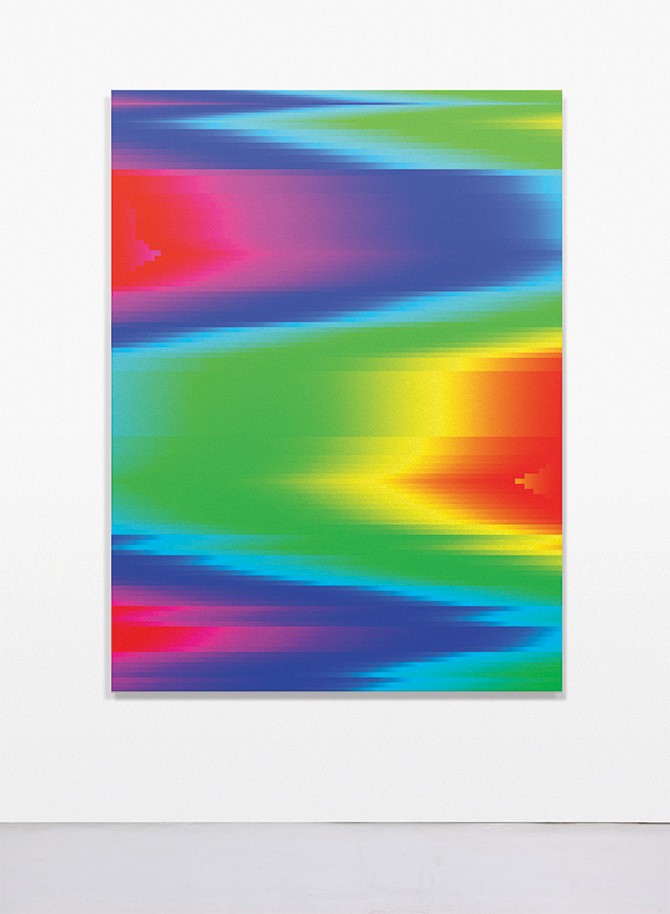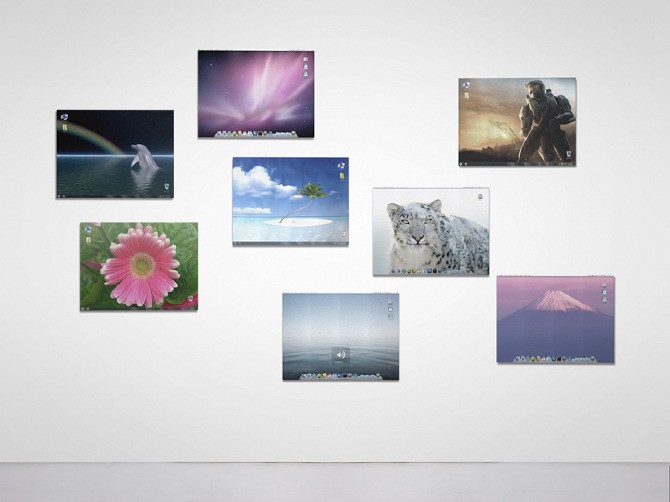
BG Painting 001 UV Paint on canvas. 100x140x3 cm. 2013
Please tell in a few words about your background.
I’m self-taught artist who works in newmedia and internet since 1999.
Please tell about your online activities as well as the off-line ones.
I do not really differences between offline and online for me it is the same reality.
If there is some particular reason why you started to make your works, please tell about it.
My source of inspiration is the art history, popular culture and the Internet. Whatever happens in these fields can generate a new art project.
About your GIF works. Why do you use GIF format? It is credited as GIF, so I think it is like capturing forms of images as a material. Is it something you do consciously?
I started using the GIF format long ago when I worked in an online advertising agency, I’m fascinated by possibilities of the format since them and I feel very close to it generationally. In some cases, i think is the most appropriate format to address issues that require immediacy and movement.
I also think that the revival of GIF format is happening now in the internet. What do you think is so attractive about it?
What happens now is that thanks to the work of a generation of artists who have taken seriously the format along with the emergence of social networking sites like tumblr, has managed to take the GIF from their marginal environment and elevate it to an art format.

Pigeon GIF, 500×400 px. 2013

Lamp GIF, 500×400 px. 2013
Your works that use Google Earth and sculpture works that can be seen in browser, they can be seen as an attempt to make new kind of sculptures on the internet. What do you think are the main characteristics of the sculptures in internet?
Internet and 3D tools have made to reconsider what we thought hitherto sculpture. New tools and how we interact on the Internet have expanded traditional notions up points that have not yet been fully defined.
In my curatorial project for Cerma, “What we call sculpture” there is ample information on this topic and what was proposed in the discurse of the concept of sculpture on the Internet:
The show focuses on the possibilities of sculpture through the use of digital tools in the context of Internet and the exhibition possibilities of the online medium.
Since the advent of video games and the Internet, the notion of actual physical space has been complemented by the existence of virtual spaces, built using code and 3D software where graphics you can see on the screen not only occupy a physical space as storage on a hard disk, but through contemplation or interaction with simulated spaces we can perceive aspects as size, material and volume, all typical of traditional sculpture.
From Mario Bros for Nintendo 64 in the entertainment industry, through social networks like Second Life, to come up with new ways in which we perceive the real world using simulators such as Google Earth, the products generated by 3D software tools have changed dramatically shaped the way we relate and understand the real space, so much so, that an architect can now recognize the version of AutoCad with which a building is designed.
What we call sculpture is a collection of works that use sculpture procedures, installation, intervention, etc. as a means of digital experimentation to develop artistic strategies online.
New Ruins. Google Earth Tour.
I think that in your work a big influence from the glitch can be seen in the usage of the colours. What do you think about it?
I like to use glitches because they use the error that occurs on a digital image aesthetically and conceptually.
The error has been a great source of inspiration in the field of art in the past, perhaps the best known is the abstract expressionism but this was inspired by the surrealism that used the random error and the unknown as sources of inspiration.
From the series Broken Gradients I used glitch aesthetics as a type of image that necessarily occurs in present time because before there was no technology that makes this possible. I like the experimental possibilities of digital imaging and as extended by his mistake. I am very interested in the concept of traffic and circulation underlying in the image, an image that has been corrupted because it has been broadcast over the Internet. Conceptually for me are the screen shot of an image that has decomposed during his journey and that it has not yet put back.
What is the reason for using internet and computer culture for your work? What do you think are the possibilities for the future?
I think they are the tools and the natural context of the time in which we live. No context or previous tools have offered many creative possibilities of exploration as we enjoy in the present. Looking ahead the chances are far greater in really enter into the Internet of Things.
You are running an online gallery called Domain Gallery, what was the reason why you had an idea to start doing it? How do you select the artists?
I started with the gallery for a year and a half in order to give visibility to a generation of artists working with new technologies and the Internet, they are creating pieces almost exclusively for this medium and are not taken into account in the circuit traditional contemporary art yet.
There is no rule to determine the selected artists, i select projects that interest me and I think that could also interest to more people.
Is there anything in particular that interests you now except art?
Botany and bodyboard.
Desktop Screenshot Painting Oil on canvas. 60×40 cm. 2012.
Manuel Fernández
Born in Málaga, 1977. Manuel Fernández is a spanish artist based in Madrid. His artistic practice begins at the intersection of art, popular culture and Internet. He explores the impact of technologies on society and how they have radically change the way we perceive and experience reality. Through media such as web, painting, animated gif, sculpture, video, photography and printing, he investigates on new processes involved in the creation and production of the art object, in its distribution, presentation and in their simultaneous consumption in the real and virtual space in the era of Internet of things. Fernández is founder and curator of Domain Gallery a web based gallery focused on digital and internet based works.
http://www.manuelfernandez.name
